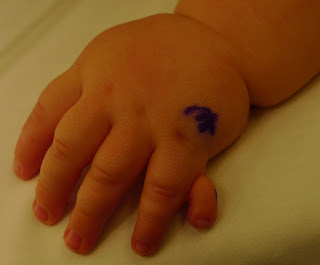An extra finger on the pinky side of the hand is one of the most common birth anomalies of the hand. The official name is ulnar polydactyly or postaxial polydactyly. It is typically seen in African Americans and is usually passed on as an autosomal dominant trait. OMIM has numerous details: http://omim.org/entry/174200?search=postaxial%20polydactyly&highlight=postaxial%20polydactyly
In caucasians, it is unusual and may be associated with a syndrome, such as Ellis Van Creveld, among others. http://omim.org/entry/225500?search=postaxial%20polydactyly&highlight=postaxial%20polydactyly
We can help rule out an associated syndrome.
 |
| Small extra digit, a postaxial polydactyly. |
 |
| Another view of the extra digit prior to surgical excision |
Hand surgeons such as myself often do not see these patients with small extra digits because they may be treated in the newborn nursery. In these situations, the extra digit is “tied off” such that the blood supply is blocked and the finger necroses (turns black) and eventually falls off. The process is typically non painful and usually is a successful treatment. The small side effect with this treatment is that there will be a skin lesion at the site of the previous attachment, essentially what appears to be a wart.
 |
| Small “wart” after “tie off” procedure for ulnar polydactyly |
 |
| Another example of skin lesion after a “tie off” procedure for ulnar polydactyly |
For that reason, when I am able to see patients with postaxial polydactyly in the office, I offer two treatment options: the office based “tie- off” procedure and a formal surgery. The surgery is quite small and offers an appearance benefit. It is a very different surgery than reconstruction of other extra digits, such as radial polydactyly. http://congenitalhand.wustl.edu/2012/05/difficult-extra-thumbs.html
Either way, most patients with this anomaly do wonderfully.